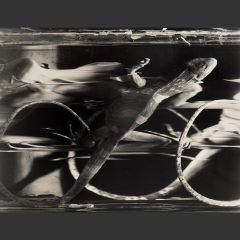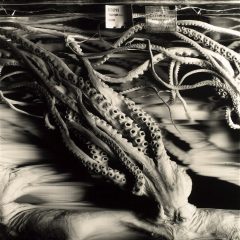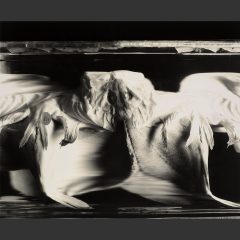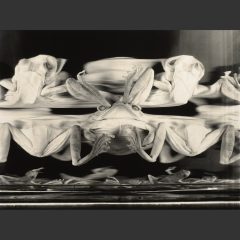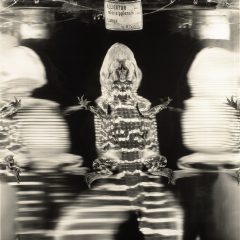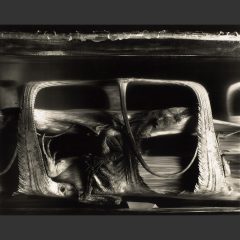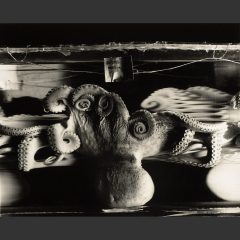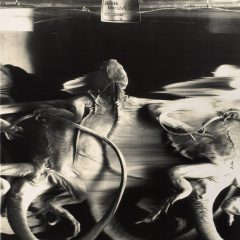série FORMOL’S BAND (1986)
Le cerveau humain » se souvient « , mais il n’enregistre pas toutes les étapes qui se déroulent devant ses yeux. Il bâcle radicalement les détails. En terme mathématique, on pourrait dire que le cerveau sait très bien intégrer mais bien mal additionner. Prenons par exemple un vase décoré façon champêtre et faisons-le doucement tourner dans la main. Que percevons-nous ? La représentation d’un cheval puis d’un paysan puis d’un arbre et ainsi de suite jusqu’au retour au point de départ. Mais, qu’avons-nous retenu du petit manège ? Rien que des reconnaissances globalisées (paysan, cheval, arbre) mais aucune des transitions qui sont pourtant les étapes tangibles et obligatoires de la rotation du vase.
Curieusement, ce que le cerveau ne sait pas faire ou néglige, la photographie, en bonne additionneuse méthodique, peut le faire ! En périphotographie, l’image du tour du vase n’a plus rien à voir avec celle que notre oeil a retenue. Ainsi, le décor champêtre, avec ses personnages ou animaux distincts, devient un curieux ruban où cheval, paysan, arbre se suivent à la queue leu leu dans un panorama continu. Ce qui était palpablement cylindrique devient rectangle. Tout se passe comme si le souvenir de l’objet, enroulé dans notre tête comme un tapis encombrant, était soudain comme libéré de sa ficelle et développait alors toute l’ampleur de sa surface…
La série » Formol’s Band » est ce jeu du tapis déroulé appliqué à des vases contenant des animaux naturalisés dans du formol. Avec la périphotographie, ces bocaux deviennent des cylindres » à voir « , exactement comme peuvent l’être » à entendre » les rouleaux de cire de nos vieux phonographes.
Comme ces périphotographies ne témoignent plus de la représentation du bocal que nous tenions en main, nous pourrions en conclure que ces chimères sont l’effet d’une simple distorsion spatiale, mais ce serait oublier que ce que nous lisons comme droite et gauche de l’image périphotographique représente, en fait, le début et la fin d’un processus. Il n’y a donc ni droite ni gauche mais plutôt un avant et un après. La géométrie de l’image contient (cache) un temps qui peut prendre toutes les valeurs, suivant la lenteur de l’enregistrement.
Imaginons un instant le » déroulé » du portrait d’un modèle, très patient, consacrant toute une vie à poser devant cette machine infernale pour aboutir à l’image, cohérente et continue, d’un visage où s’inscriraient, à droite, le début de son oreille d’enfant, au centre, ses yeux d’adulte et, à gauche, la fin son autre oreille de… vieillard !
Ceci est un projet de travail, pour ma prochaine éternité…
30 éléments 60 x 50 et 100x 80 cm. Périphotographies. Epreuves au Chlorobromure d’argent avec virage.
The human brain consigns to memory, but does not register everything that goes on before the eyes. It scraps a lot of the details. In mathematical terms, one could say that the brain is good at integrating but very bad at adding up…
Imagine you are holding a vase decorated with country scenes and turning it gently round in your hands. What do you see? a picture of a horse and a peasant, and then a tree, and so on until you get back to where you started. But what will you have remembered of the scene? Nothing but the recognisable elements (horse, peasant, tree), and none of the concrete and obligatory transitions taken to make the vase turn. Strangely enough, what the brain cannot or will not do, photography, the great methodical adder-up, can and does!
In periphotography, the image on the vase has nothing to do with what our eye has registered. The country scene decorating it,with clear figures and animals, becomes a curious sequence where horse, peasant and tree file past one after the other in a continuous landscape. That which was a cylinder to the touch becomes a rectangle to the eye. It is as if the memory of the object, rolled up in our head like an old carpet, were suddenly freed from the string holding it together and spread out to its full length…
In the Formol’s band series, the unrolled carpet game is applied to jars that contain animals preserved in formaldehyde. Periphotography turns them into « visual » cylinders, just as the wax cylinder records of old phonographs were made for listening. As periphotographs do not represent what we remember of the jar from turning it round in our hands, we could conclude that these images are simply the effect of spatial distortion, but that would be to forget that what we read as right and left of the image actually represents the beginning and the end of a process. There is therefore neither right nor left but rather a before and an after. The geometry of the image contains, and hides, the element of time that can take on any value, depending on the duration of its recording.
Let us imagine for a moment the « unfolding » of a portrait of an extremely patient model willing to dedicate a lifetime to posing in front of that infernal machine to produce the smooth, even image of a face where the right side is that of a child, the eyes in the centre those of an adult and to the left, finally, the ear of an old man…!
That is one of the projects I shall be working on in my next eternity.
30 elements 60 x 50 and 100x 80 cm. Periphotographs. Silver chlorobromide prints with toning. Periphotographs.

